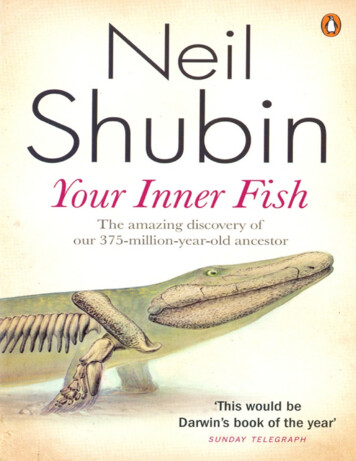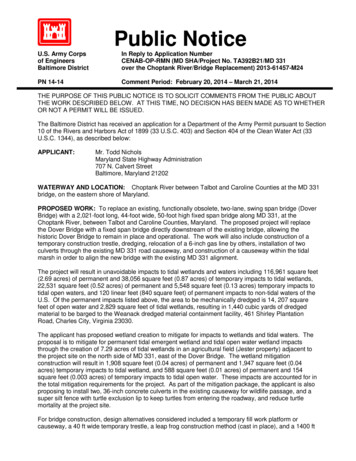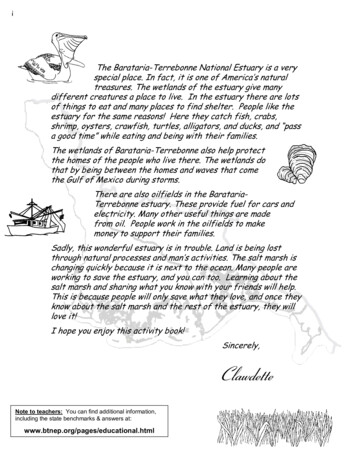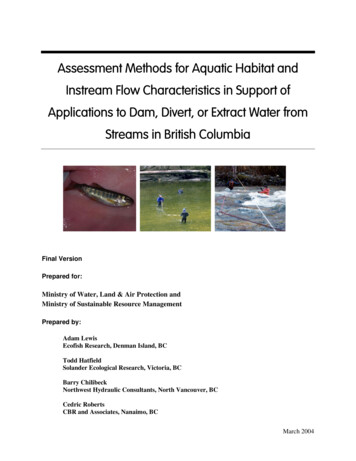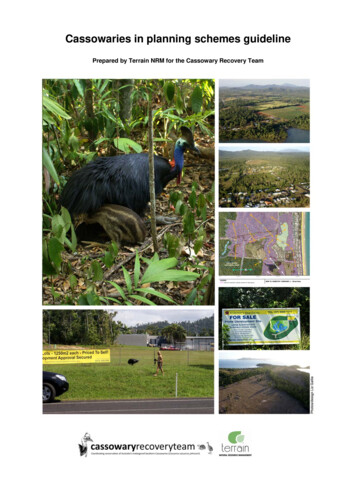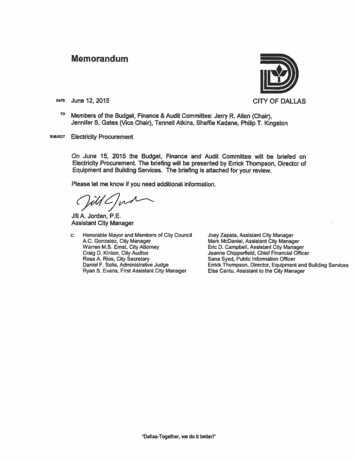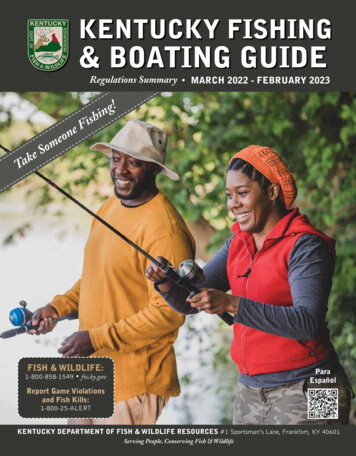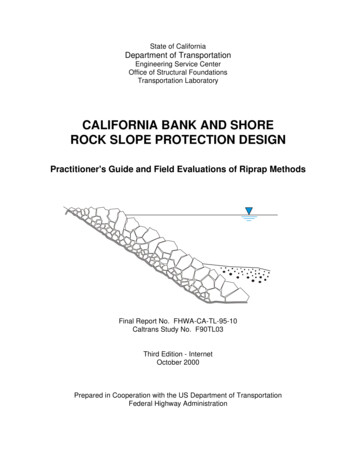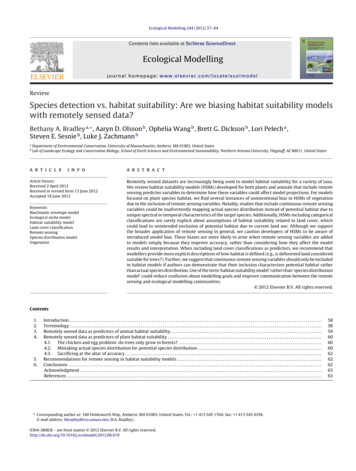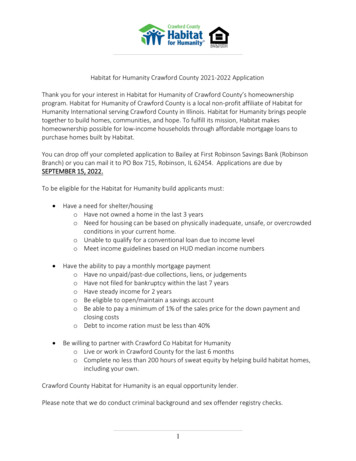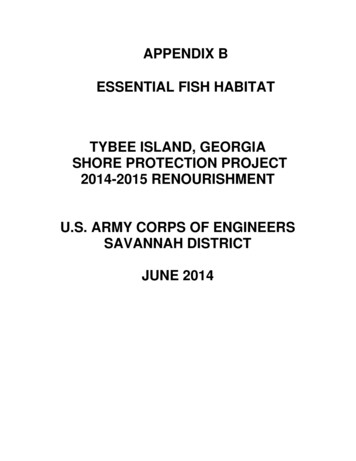
Transcription
APPENDIX BESSENTIAL FISH HABITATTYBEE ISLAND, GEORGIASHORE PROTECTION PROJECT2014-2015 RENOURISHMENTU.S. ARMY CORPS OF ENGINEERSSAVANNAH DISTRICTJUNE 2014
Final Appendix B Section EFHTybee Island, GeorgiaShore Protection Project 2014-2015 RenourishmentThis page intentionally blank.EA-B-2
Final Appendix B Section EFHTybee Island, GeorgiaShore Protection Project 2014-2015 RenourishmentESSENTIAL FISH HABITAT ASSESSMENTTybee Island, GeorgiaShore Protection Project 2014-2015 Renourishment1.0INTRODUCTIONThe purpose of this document is to present the findings of the Essential FishHabitat (EFH) assessment conducted for the proposed Tybee Island ShoreProtection Project as required by the Magnuson‐Stevens Fishery Conservation andManagement Act of 1976, as amended through 1996 (Magnuson‐Stevens Act).The objectives of this EFH assessment are to describe how the actions proposedby the project may affect EFH designated by the National Marine Fisheries Service(NMFS) and the South Atlantic Fisheries Management Council (SAFMC).The EFH assessment will include a description of the proposed action, coordinationhistory, an analysis of the direct, indirect, and cumulative effects on EFH for themanaged fish species and their major food sources, and the District viewsregarding the effects of the proposed action.This evaluation is conducted in accordance with Section 305(b) (2) of theMagnuson-Stevens Fishery Conservation and Management Act (As AmendedThrough October 11, 1996). That provision states: "Each Federal agency shallconsult with the Secretary with respect to any action authorized, funded, orundertaken, or proposed to be authorized, funded, or undertaken, by such agencythat may adversely affect any essential fish habitat identified under this Act." It isalso done in accordance with the Interim Final Rule (par. 600.920(g)) that requiresan EFH Assessment contain the following: (1) Description of the Proposed Action,(2) An Analysis of the Effects, including cumulative effects, of the action on EFH,the managed species, and associated species by life history stage, (3) TheFederal agency's views regarding the effects of the action on EFH, and (4)Proposed mitigation, if applicable.2.0PROJECT DESCRIPTIONThis authorized 3.5 mile long project was initially constructed in 1974 with a 50year project life and periodic renourishments to occur every 7 years. The beachwas last renourished in 2008 and is scheduled to be renourished again in 2015. In2015, there will be 9 years left in the project life (i.e. Federal participation). TheSavannah District, with the non-Federal sponsor’s concurrence, selected toEA-B-1
Final Appendix B Section EFHTybee Island, GeorgiaShore Protection Project 2014-2015 Renourishmentperform the 2015 periodic renourishment for the remaining 9 years of the 50-yearproject life.Beach fill final placement will be based on physical conditions and funds availableat the time of construction. Alternative bid schedules will be used to optimize thequantity of beach fill placed for the funds available. The proposed project isexpected to commence by November 2015, and be completed by April 30, 2016.No construction would occur during sea turtle nesting and hatching season, 1 May– 1 October. Federal participation in the Federal project expires in 2024, 9 yearsafter the time of the proposed construction.The current project template design is based on project performance and erosionrates since the last renourishment project in 2008. Beach fill will primarily beplaced in areas included in the previous renourishment in 2008. Figure 1 displaysthe proposed placement locations. These areas include the North Beach (NorthEnd Groin to Oceanview Court), Second Street area (Oceanview Court to CenterStreet), Middle Beach (Center Street to 11th Street), South Beach (11th Street toSouth End Groin), and Back River/Tybee Creek (South Tip Groin Field to InletAvenue). Additional fill will be placed between these areas to provide a morestable beach profile and to avoid some of the excessive losses in the 2nd Street“hot spot”, a highly erosional area. Constructed beach widths on the Back RiverBeach vary from 30 feet to 110 feet at 11.22 feet mean lower low water (MLLW).Constructed beach widths on the Front Beach will vary from a 25 foot width berm,to a berm approximately 350 feet wide at the elevation of 11.22 MLLW. Thedesigned Front Beach slope is 1V:25H, based on experience with previousnourishments. The Back River will have an 11.22 foot elevation MLLW and a1V:15H slope. Figure 2 shows the proposed template slopes.EA-B-2
Final Appendix B Section EFHTybee Island, GeorgiaShore Protection Project 2014-2015 RenourishmentFigure 1: Proposed Template For Recommended AlternativeEA-B-3
Final Appendix B Section EFHTybee Island, GeorgiaShore Protection Project 2014-2015 RenourishmentFigure 2: Proposed Slope**Back River Beach will have a slope of 1V:15HEA-B-4
Final Appendix B Section EFHTybee Island, GeorgiaShore Protection Project 2014-2015 RenourishmentThe 2015 renourishment consists of placing fill volume to restore the project plus anadditional 312,000 cubic yards (c.y.) to account for potential erosion through 2024.In addition, the berm will be extended seaward up to 50 feet beyond the previouslyconstructed template to account for erosion during the additional 2 years for a 9year cycle. The beach template will be slightly modified to include placement of theadditional 312,000 c.y. of material by extending the berm north to the terminal groinof the template. This area has been nourished during previous renourishmentcycles, but not during the 2008 renourishment. Figure 3 shows the proposed filllimits and locations.A portion of Borrow Area 4 was utilized during the 2008 renourishment andproduced highly compatible beach renourishment material. Within this site not allareas were disturbed in 2008 and enough high quality material remains for use in2015. The borrow area is approximately 4,000 feet (0.75 miles) southeast of thesouthernmost Federal terminal groin. Figure 4 shows Borrow Area 4 andlocations of previously dredged area and area proposed for use during the 2015project.As proposed, the project will be constructed using a hydraulic cutterhead pipeline.A submerged pipeline will extend from the borrow site to the southerly tip ofTybee Island. Shore pipe will be progressively added to perform fill placementalong the shorefront areas to be renourished. Temporary toe dikes willconstructed parallel with the shore to control the hydraulic effluent and reduceturbidity. The sand will be placed in varying design templates based uponalongshore volumetric fill requirements which reflect beach conditions at the timeof construction.EA-B-5
Final Appendix B Section EFHTybee Island, GeorgiaShore Protection Project 2014-2015 RenourishmentFigure 3: Proposed Fill Limits For 2015 Tybee Beach RenourishmentEA-B-6
Final Appendix B Section EFHTybee Island, GeorgiaShore Protection Project 2014-2015 RenourishmentFigure 4: Proposed Borrow AreaEA-B-7
Final Appendix B Section EFHTybee Island, GeorgiaShore Protection Project 2014-2015 Renourishment2.1CoordinationSavannah District initiated EFH consultation of the proposed project with theNational Oceanic and Atmospheric Administration (NOAA) Fisheries HabitatConservation Division and is received concurrence with the effects analysis andconservation recommendations found in Appendix E.Prior Tybee Island EFH Coordination:1995 renourishment - NMFS expressed concerns on project impacts to a) LittleTybee Island, b) potential contaminant releases associated with the use of dredgedmaterial taken from the Savannah Bar Channel, c) status of living marineresources within the borrow areas, d) impacts to beach benthic organisms, e)impacts to hard bottoms, f) impacts to larval fish and shellfish, g) and suitability ofmaterial in the borrow area and potential contaminant releases and recommendedcoordinating with EPA.Corps responses a) The borrow area chosen was outside of the area that couldimpact Little Tybee, b) borrow area material was tested and found suitable forocean disposal however, the material selected for beach nourishment will be testedagain for contaminants to ensure suitability for beach placement, c) coordinationwith GA DNR indicated no concerns for existence of communities in the borrowarea that could be impacted, d) similar habitat for these benthic organisms isavailable nearby on Little Tybee and on areas outside of the template at Tybee.Impacts are expected to be short-term as these species will likely recolonize, e) nohard bottoms exist in the area, f) recommendations by USFWS and GA DNR havebeen to avoid construction activities during 1 March – 1 June. Norecommendations were made by NMFS for other avoidance windows, based oncurrent knowledge no work will occur during 1 March – 1 June, g) the Section 103report for deepening Savannah Harbor evaluated sediment samples and foundthem acceptable for ocean disposal. EPA concurred with the 103 evaluation.2000 renourishment - NMFS provided the following comments- a) Sandnourishment should not occur during 15 May through 31 October, b) Cumulativeimpacts of beach nourishments along the southeastern Atlantic coastline should beexamined, and c) Restrictive work zones should be established to protect tidalflats, vegetated dunes and wetlands.Corps responses a) Construction would not occur during this time period, b)Hydrology evaluations and monitoring studies were conducted to determine if anycumulative effects were likely to adjacent shorelines, such as Little Tybee. Nonegative impacts were anticipated. c) Staging areas were designated to minimizeconstruction traffic and protect sea dunes and other beach vegetation.EA-B-8
Final Appendix B Section EFHTybee Island, GeorgiaShore Protection Project 2014-2015 Renourishment2008 renourishment – NMFS provided the following comments – a) To minimizethe potential impacts to fishery resources from incompatible sediments, NMFSrecommends close monitoring of sediment characteristics during sand placementand strict enforcement of the depth limitation at the borrow area, b) implementationof a biological monitoring program focused on measuring the recovery of benthiccommunities at both the beach and borrow areas. Post-construction monitoringshould occur during the spring and fall for three years after construction iscompleted.NMFS provided three conservation recommendations: 1. The borrow area shall bemined selectively to reduce the amount of silt and shell placed on the beach. Amonitoring program shall be implemented to document any changes to sedimenttexture along the beach and to characterize, relative to reference areas, theabundance and fishery value of infauna within the fill area. The monitoring plansshall be submitted to NMFS for approval prior to construction.2. Bathymetric surveys shall be conducted immediately after and one year afterproject completion to demonstrate compliance with dredging depth restrictions andto demonstrate the borrow areas are filling at rates presumed acceptable forfishery resources.3. A monitoring program shall be implemented at the borrow area to documentfilling rates, nature of the material that fills the pit, and the impact the pit has onthe use of the sea bottom by fish. The monitoring plans shall be submitted toNMFS for approval prior to construction.Corps responses to comments- a) The borrow area has been investigated andresults have shown sediments compatible with beach quality to a depth of -16 feetMLW. A copy of the 2007 Geotechnical Investigation which documents the resultshas been provided to NMFS. The percent fines content for all material to beexcavated above -16 feet MLW averages less than 1%. Furthermore, we believepre-project characterization reflects what should be expected post-project, sinceborrow would take place in the same general area as the last nourishment. Forthese reasons we do not feel a monitoring plan is warranted, b) Tybee IslandMarine Science Center located on the south beach of Tybee Island, has beenconducting marine science education programs since 1987. The programs haveincluded beach seining, sediment characterization, and invertebrate studies. Thecenter receives financial support from the Tybee Island Marine ScienceFoundation, the City of Tybee Island, and the Georgia Department of NaturalResources. We suggest using data collected by the Science Center to assessfishery resources in the area. We recognize the data will not be as rigorous innature as that of research scientists however, but should provide relevantcumulative baseline data that would otherwise be difficult to assimilate.EA-B-9
Final Appendix B Section EFHTybee Island, GeorgiaShore Protection Project 2014-2015 RenourishmentCorps responses to conservation recommendations:1 & 3. A monitoring program will be conducted by the South Carolina Departmentof Natural Resources Marine Resources Research Institute (SCDNRMRRI) onboth the borrow area and beach. This monitoring program has been approved byNMFS. Results of this monitoring are included in the 2015 EA.2. Bathymetric surveys will be conducted by the District immediately following theproject and after one year to demonstrate compliance and document fill rates.Survey’s performed by SCDNR 4 months, 6 months and 12 months after therenourishment indicated the borrow area experienced an increase in silts andclays (from less than 2% pre-dredging to 12% twelve months post-dredging).3.0SPECIES WITH FEDERAL FISHERY MANAGEMENT PLANSAlthough the SAFMC manages numerous fish stocks, only those that have FederalFishery Management Plans (FMPs) have designated EFH. Therefore, thisassessment is limited to such species. The Middle Atlantic Fishery ManagementCouncil (MAFMC) manages the following species that may inhabit the nearshore oroffshore areas of Tybee Island; bluefish (Pomatomus saltatrix), black sea bass(Centropristis striata), butterfish (Peprilus triancanthus), tilefish (Lopholatiluschamaeleonticeps), Summer Flounder (Paralichthys dentatus), and Atlanticsurfclam (spisula solidissima). Other fisheries under jurisdiction of the SAFMCinclude brown shrimp (Penaeus aztecus), pink shrimp (P. duorarum), white shrimp(P. setiferus), cobia (Rachycentron canadum), dolphin (Coryphaena hippurus), redsnapper (Lutjanus campechanus), gag grouper (Mycteroperca microlepis), kingmackerel (Scomberomorus cavalla), Spanish mackerel (Scomberomorusmaculatus), spot (Leiostomus xanthurus), and select coastal shark species.Section 6.0 describes the species and FMPs in detail.4.0EFH DESIGNATED BY THE SAFMC and MAFMCTable 1 shows EFH as identified in Fishery Management Plan Amendments for theSAFMC and MAFMC, geographically defined areas of particular concern andwhether or not these areas/habitats occur within the project vicinity or if areas willbe impacted by project activities. Areas listed in this table were derived fromSAFMC’s Fishery Ecosystem Plan (SAFMC, 2009) and MAFMC’s EFH sourcedocuments (www.nefsc.noaa.gov).EA-B-10
Final Appendix B Section EFHTybee Island, GeorgiaShore Protection Project 2014-2015 RenourishmentTable 1.Essential Fish Habitat Areas in Georgia Waters*Essential Fish HabitatTidal freshwater1,2wetlandsEstuarine emergentwetlands (e.g.,1,2brackish/salt marsh)Subtidal/intertidal non1vegetated flats4,5Coastal inlets2,3Coral reefs2,3Live/hard bottom2Unconsolidated bottom4Gulf Stream6Oyster reefs/shell bank8Charleston BumpSandy shoals of capes7and offshore bars4Surf zoneHigh salinity bays,4estuariesPotential PresenceNear ProjectIn ProjectAreaImpact AreaNoNoPotential esYesYesYes*Georgia waters lack some habitat designated as EFH by the SAFMC (e.g., submerged aquatic vegetation(SAV) and mangroves) therefore those habitats are not included in this table. Similarly, because of itsnearshore location, offshore EFH such as sargassum and medium to high profile outcroppings and rockybottom are also not included in this table.1These habitats are EFH for penaeid shrimp.2These habitats are EFH for snapper-grouper.3These habitats are EFH for specific life stages of estuarine-dependent and nearshore snapper-grouper.4These habitats are EFH for coastal migratory pelagics (e.g., Spanish mackerel and cobia).5Coastal inlets are EFH-HAPCs for all snapper-grouper and EFH for coastal migratory pelagics.6Oysters are EFH-HAPCs for snapper-grouper.7These habitats are EFH for coastal migratory pelagics.8This habitat is EFH for wreckfish and highly migratory pelagics4.1Estuarine Emergent WetlandsNOAA defines estuarine emergent wetlands as initially determined by Cowardin etal. (1979) and considered to be the Federally-accepted standard: “Deepwater tidalhabitats and adjacent tidal wetlands that are usually semi-enclosed by land but haveopen, partly obstructed, or sporadic access to the ocean, with ocean-derived waterat least occasionally diluted by freshwater runoff from the land. The upstream andlandward limit is where ocean-derived salts measure less than 0.5 ppt during theperiod of average annual low flow. The seaward limit is (1) an imaginary line closingthe mouth of a river, bay, or sound; and (2) the seaward limit of wetland emergents,shrubs, or trees when not included in (1).” Estuarine wetlands are important nurseryEA-B-11
Final Appendix B Section EFHTybee Island, GeorgiaShore Protection Project 2014-2015 Renourishmentgrounds for many fish, shellfish, and other invertebrate species. In addition toproviding shelter and food wetlands also serve as erosion deterrents.4.2.Subtidal and Intertidal non-vegetated FlatsIntertidal areas and mudflats are important dwelling habitat and feeding areas forbenthic macroinvertebrates, juvenile fish species, arthropods, mollusks, andpredatory organisms that feed on these species. This tidally influenced,constantly changing EFH provides feeding grounds for predators, refuge andfeeding grounds for juvenile and forage fish species, and nursery grounds forestuarine dependant benthic species (SAFMC1998). Animals that move from a pelagic larval to a benthic juvenile existencemake use of these EFH flats for life stage development. These flats can provide acomparatively low energy area with tidal phases which allow species the use ofshallow water habitat as well as relatively deeper water within small spatial areas.These flats also serve as refuge areas for species avoiding predators, which usethe tide cycles for access to estuarine feeding grounds (SAFMC 1998).4.3Coastal InletsCoastal inlets are a connecting passage between two bodies of water. Thistypically refers to tidal openings in barrier islands, but can also be applied to rivermouths in tidal and non-tidal ry). These areas serve as migratorycorridors for fishery resources that utilize oceanic and estuarine habitats (SAFMC,1998). Coastal inlets are closely connected to beach stability, estuary health,exchange of nutrients, water, and sediments between estuaries and the ocean,and recreational opportunities (USACE CIRP, 2008) http://cirp.usace.army.mil/.Coastal inlets are EFH-HAPCs for all snapper-grouper and EFH for coastalmigratory pelagics. In addition, the Mid-Atlantic Fishery Management Councildesignates coastal inlets as EFH for bluefish and the NMFS designates coastalinlets as EFH for a variety of sharks. Coastal inlets provide protection and serve asnursery grounds for fish species including blue fish, black sea bass, butterfish,summer flounder, red drum, cobia, and Spanish mackerel.4.4Live/Hard bottomGrays Reef National Marine Sanctuary is one of the largest live-bottom reefs inthe state. The sanctuary is located approximately 40 miles southeast of TybeeIsland and is not likely to be impacted by the project. There are other patches oflive and hard bottom areas scattered along the outer continental shelf near theproject area however, no impacts are expected as a result of the project to thesehabitats.EA-B-12
Final Appendix B Section EFHTybee Island, GeorgiaShore Protection Project 2014-2015 Renourishment4.5Unconsolidated BottomUnconsolidated bottom is defined by USGS as all wetland and deepwater habitatswith at least 25% cover of particles smaller than stones, and a vegetative coverless than 30%. Water regimes are restricted to subtidal, permanently flooded,intermittently exposed, and semi-permanently flooded. Diverse assemblages ofbenthic macroinvertebrates utilize these areas and serve as food sources fordemersal fish species.4.6Oyster Reefs Shell BanksOyster reefs and shell banks are defined by SAFMC as being the, “naturalstructures found between and beneath tide lines, which are composed of oystershell, live oysters and other organisms”. This habitat is usually found adjacent toemergent marsh vegetation and provides the other three‐dimensional structuralrelief in soft‐bottom, benthic habitat (Wenner et al., 1996). Optimal salinity forCrassostrea virginica ranges from 12ppt to 25ppt, and in Georgia the majority ofreefs are intertidal. Oyster reefs are extremely important to the aquatic ecosystemas they remove particulate matter, release inorganic and organic nutrients, stabilizesediments, provide habitat cover and serve as both indirect (i.e. housemacroinvertebrates) and direct food sources for various fish species.4. 7Sandy Shoals of bays and Offshore BarsOffshore bars are shore-parallel deposits of sand existing seaward of the lowerlow water line. Offshore bars are formed from sand migrating off and onto thebeach. Sand is carried by waves during storm events or by long-shore transport.Offshore bars are subtidal and typically break up wave energy depending on theirheight below mean sea level. This breaking helps dissipate on-shore breakingand creates the surf zone, the choppy area between the offshore bar and thebeach.4.8Surf ZoneThese areas are zones of wave action extending from the water line (which varieswith tide, surge, set-up, etc.) out to the most seaward point of the zone (breakerzone) at which waves approaching the coastline commence breaking, typically inwater depths of between 5 to 10 meters. On Tybee surf breaks often occur inmuch shallow depths, less than 1 meter and may break onshore. Surf zones areareas of high wave energy between the beach and the low water line. This areaserves as an important nursery and feeding habitat for many species of juvenilefish.EA-B-13
Final Appendix B Section EFHTybee Island, GeorgiaShore Protection Project 2014-2015 Renourishment4.9High Salinity Bays and EstuariesEstuaries are areas where fresh water rivers and marine seas converge.Estuaries serve as EFH for many managed species and their prey, by providinghabitat for spawning, breeding, feeding, and growth.5.0GEOGRAPHICALLY DEFINED HABITAT AREAS OF PARTICULARCONCERNHabitat Areas of Particular Concern (HAPC) are a subset of EFH that is either rare,particularly susceptible to human-induced degradation, especially importantecologically, or located in an environmentally stressed area (SAFMC, 1998). TheSAFMC is responsible for the conservation and management of many speciesfound in Federal waters in the South Atlantic Region. The Council currently hasFishery Management Plans (FMPs) for five fisheries that may occur in the projectarea. These include coastal migratory pelagics, penaeid shrimp, snapper-grouper,and dolphin-wahoo, as well as coastal sharks which are managed by NMFS. Ofthese fisheries snapper-grouper contain species that are overfished. Both therecreational and commercial snapper-grouper fisheries are highly regulated andprogress continues to be made as more species are removed from the overfishedlist each year. The other fisheries are expected to continue into the future atproductive sustainable levels (www.safmc.net). Table 2 lists the HAPC andmanaged species that may occur in the project area.Table 2.Habitat Areas of Particular Concern potentially occurringin the Tybee Island areaHabitat Areas of Particular ConcernCoastal MigratoryPelagicsSpeciesKing and Spanishmackerel, cobiaEFHCoastal InletsPenaeid ShrimpShrimp (brown,white and pink)Salt marsh,subtidal/intertidalflats,Red snapper, Gaggrouper,Oyster reefs, coastalinlets, salt marsh,live/hard bottom,Snapper GrouperComplexEA-B-14
Final Appendix B Section EFHTybee Island, GeorgiaShore Protection Project 2014-2015 phin-WahooLive/Hard bottomLive or HardbottomSnapper-Grouper5.1Coastal Migratory PelagicsHAPC for coastal migratory pelagics include coastal inlets, surf zone, andestuaries.Since these species are migratory it is expected some life stage of the speciesmay be present year round in the project area HAPCs.5.2Penaeid ShrimpAreas which meet the criteria for HAPC include coastal inlets, estuarine emergentwetlands which serve as nursery grounds, oyster reefs and subtidal/intertidal flats.5.3Snapper GrouperThe snapper grouper complex utilizes both pelagic and benthic habitats throughouttheir life cycles. Larvae are free swimming within the water column. During thisstage they commonly feed on zooplankton. Juveniles and adults are frequentlybottom dwellers that associate with hard structures with moderate to high relief.The principal fishing areas are located in live bottom and shelf‐edge habitats indeeper waters. The species tend to form sizable spawning aggregations, but thismight not be the case with all species.Coastal inlets and oyster beds are considered HAPC. These areas are critical forspawning activity as well as feeding and daily movements.5.4Dolphin/WahooIn 2004 the SAFMC developed a precautionary FMP for Dolphin/Wahoo. Thesespecies are one of the highest sought in recreational fisheries. Dolphin and wahooare offshore large, fast swimming, and short lived marine fishes. Spawning occursnearshore in summer months. EFH and HAPC for dolphin and wahoo includessargassum, which is not within the project area.EA-B-15
Final Appendix B Section EFHTybee Island, GeorgiaShore Protection Project 2014-2015 Renourishment6.0Federally Managed Fish SpeciesTen families of fish containing 60 species are managed by the SAFMC. Otherspecies occurring in the project area are managed by the MAFMC. Table 3 listsfederally managed species with FMPs that may occur in the project area.Table 3.Federally Managed Species with Fishery Management Plansthat may Occur in the Project Area.Mid-AtlanticFMPs speciesCommon NameBluefishSpotSummer FlounderScientific k Sea BassCentropristis striataButterfishPeprilustriacanthusSpisula solidissimaAtlantic SurfclamFederallyImplemented FMPLemon sharkNegaprionbrevirostrisEA-B-16EFHCoastal inlets,estuariesCoastal inlets,estuariesCoastal inlets,estuaries, saltmarshCoastal lats, offshore barsCoastal inlets,estuaries, live/hardbottoms, oysterreefsCoastal inlets,estuariesUnconsolidatedbottoms, offshorebars,subtidal/intertidalnon-vegetated flatsCoastal inlets, estuaries,subtidal/intertidal nonvegetated flats, offshorebars
Final Appendix B Section EFHTybee Island, GeorgiaShore Protection Project 2014-2015 Renourishment6.1Bull sharkCarcharhinusleucasDusky sharkCarcharhinusobscuresBonnethead sharkSphyrna tiburoHammerheadsharkSphyrna mokarranAtlantic sharpnosesharkRhizoprionodronterraenovaeFinetooth sharkAprionodon isodonSandbar sharkCarcharhinusplumbeusBlacktip sharkCarcharhinuslimbatusTiger sharkGaleocerdo cuvieriCoastal inlets, estuaries,subtidal/intertidal nonvegetated flats, offshorebarsCoastal inlets, estuaries,subtidal/intertidal nonvegetated flats, offshorebarsCoastal inlets, estuaries,subtidal/intertidal nonvegetated flats, offshorebars, surf zoneCoastal inlets, estuaries,subtidal/intertidal nonvegetated flats, offshorebarsCoastal inlets, estuaries,subtidal/intertidal nonvegetated flats, offshorebarsCoastal inlets, estuaries,subtidal/intertidal nonvegetated flats, offshorebarsCoastal inlets, estuaries,subtidal/intertidal nonvegetated flats, offshorebarsCoastal inlets, estuaries,subtidal/intertidal nonvegetated flats, offshorebarsCoastal inlets, estuaries,subtidal/intertidal nonvegetated flats, offshorebarsPenaeid ShrimpThree species of penaeid shrimp (white, pink, and brown) may be found in coastalGeorgia’s waters throughout the year. EFH for penaeid shrimp includes estuarineemergent wetlands and subtidal or intertidal mudflats. Penaeid shrimp fisheryEA-B-17
Final Appendix B Section EFHTybee Island, GeorgiaShore Protection Project 2014-2015 Renourishmentseason may be regulated by either the SAFMC or the Georgia Department ofNatural Resources (GADNR). Spawning typically occurs in the spring bothnearshore and offshore.6.2Blue FishBlue fish (Pomatomus saltatrix) congregate near the edge of the continental shelf inOctober (NMFS EFH Source Document, 1999) and have coastal inlets designatedas EFH. Blue fish are migratory pelagics and may be found in both the nearshoreand offshore marine environment. Spawning occurs from March to May off theSouth Atlantic Bight.6.3Black Sea BassBlack sea bass (Centropristis striata) are migratory and have coastal inletsdesignated as EFH. Spawning occurs from May to October with a peak in June(NMFS EFH Source Document, 1999) over sandy bottoms.6.4ButterfishButterfish (Peprilus triancanthus) are migratory pelagic. Adults and juveniles havebeen recorded in Georgia estuaries but prefer salinities lower than that of the openocean (NMFS EFH Source Document, 1999) and would therefore not be expectedto occur in the project area. Coastal inlets are designated EFH for butterfish.6.5TilefishTilefish (Lopholatilus chamaeleonticeps) are omnivores and known to consumebenthic prey as well as zooplankton, other fish, and human food waste. Tilefishutilize burrows in various for
No construction would occur during sea turtle nesting and hatching season, 1 May . Second Street area (Oceanview Court to Center Street), Middle Beach (Center Street to 11th Street), South Beach (11th Street to South End Groin), and Back River/Tybee Creek (South Tip Groin Field to Inlet Avenue). Additional fill will be placed between these .
